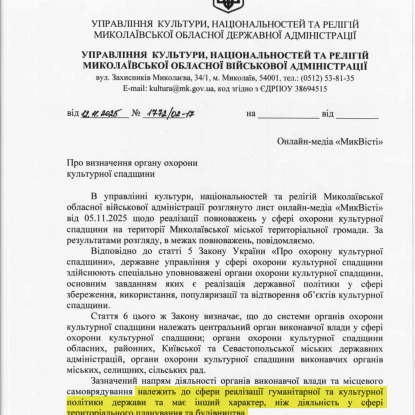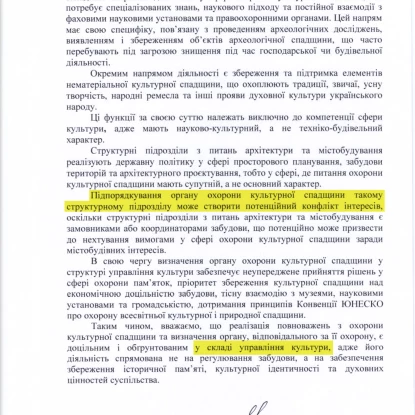How Mykolaiv can change its approach to the protection of historic buildings and what is behind it
- News of Mykolaiv
-
•
-

- Yuliia Boichenko
-
•
-
13:37, 20 November, 2025
 Heads of the Departments of Culture and Urban Development Yurii Liubarov and Yevhen Poliakov, Illustration, photo: NikVesti, archmykolaiv.com
Heads of the Departments of Culture and Urban Development Yurii Liubarov and Yevhen Poliakov, Illustration, photo: NikVesti, archmykolaiv.comThe Department of Culture of the Mykolaiv City Hall is to be deprived of the responsibility for the protection of cultural heritage sites and transferred to the Department of Architecture and Urban Planning of the Mykolaiv City Council.
This is presented by the city authorities as a reform and implementation of the recommendations of international auditors Ernst & Young, implementation of the European Anti-Corruption Initiative (EUACI) practices and ensuring democratic and good governance to make the management processes more efficient, open and balanced.
Did Ernst&Young really ask to take over the protection of cultural heritage from Liubarov?
The Ernst & Young report does not contain a single paragraph on the transfer of cultural heritage protection from the Department of Culture to the Department of Urban Development. The auditors did not propose to change the functionality of these departments and did not include them in the areas that need reorganisation. Thus, the idea to transfer this area to the urban planning unit did not come from international partners, but from within the city government.
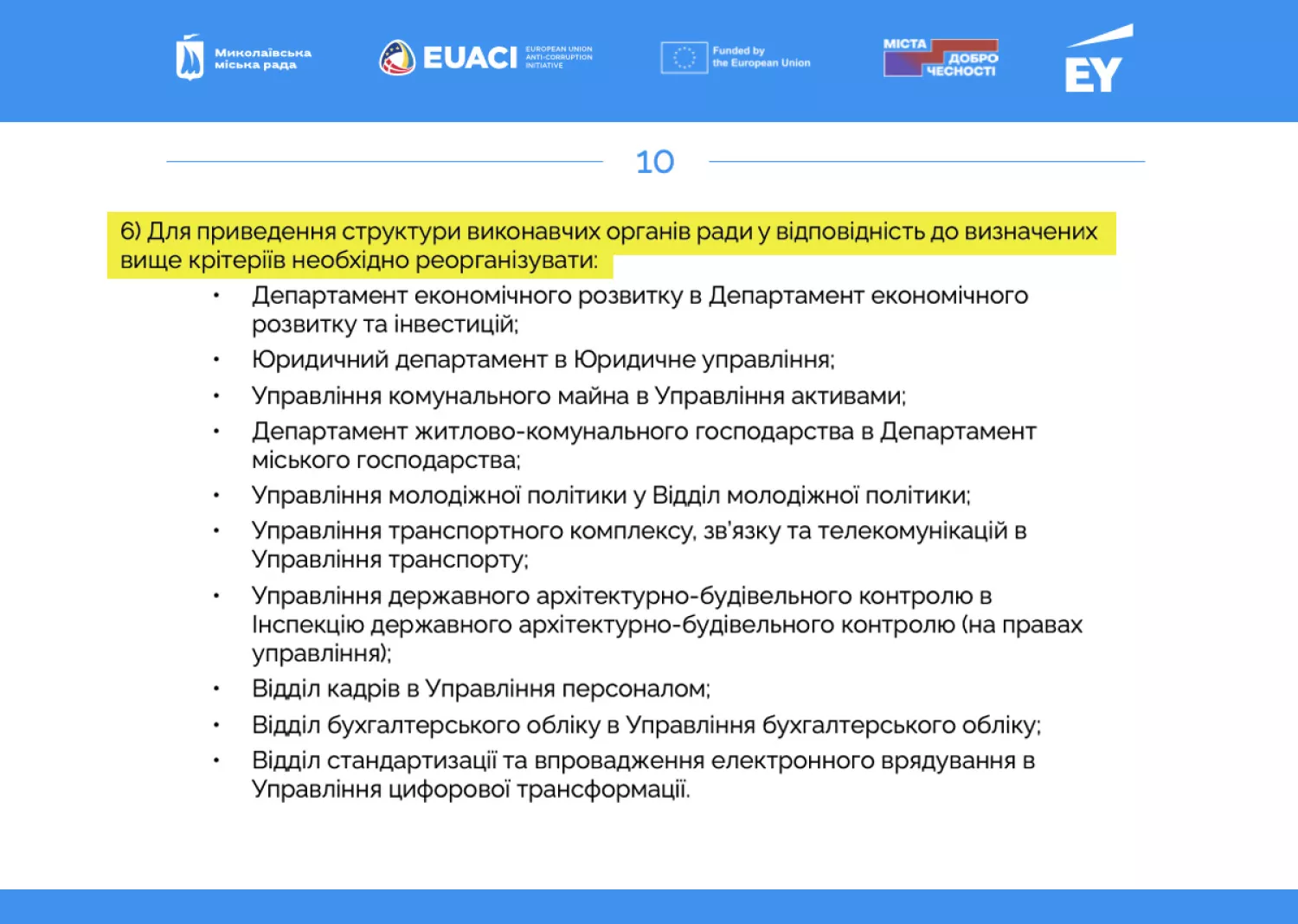 Ernst & Young report for Mykolaiv city council. The auditors did not include the Department of Culture or the Department of Urban Development in the list of departments that need to be changed
Ernst & Young report for Mykolaiv city council. The auditors did not include the Department of Culture or the Department of Urban Development in the list of departments that need to be changedThe draft decision to approve the new structure is to be considered at the next session on 27 November. It includes «The Department of Culture and Arts» (but without the protection of cultural heritage), and according to Ernst & Young's recommendations, there should be «and the Department of Culture and Tourism». The auditors called the sphere of tourism «inappropriate» for an analytical unit that should be engaged in strategic planning.
When asked by NikVesti, the head of the Economic Development Department, Tetiana Shulichenko, replied that the tourism sector would remain under her jurisdiction, despite the auditors' recommendations.
This example alone shows that the auditors' recommendations, the mayor's presentation, and the draft submitted to the session are actually three different structures.
In turn, city council deputy Mykola Kapatsyna had already stated at the previous plenary meeting of the session that the prepared reform «meets the requests of the partners» and hinted that the international community's support for Mykolaiv depends on its approval.
Where is the line between the protection of «old Mykolaiv» and the Department of Urban Development
In general, the concept of cultural heritage protection includes the preservation, registration, care and control of architectural, historical, archaeological and other valuable objects. In practice, this means that the responsible body of the city council
- maintains a register of monuments of local significance;
- monitors their technical condition;
- approves reconstructions, repairs and any works that may affect heritage sites;
- conducts or orders research and expertise;
- controls the development of historic districts;
- responds to violations and issues orders;
- interacts with the Ministry of Culture, the police, the State Emergency Service and other services.
In other words, the unit to which these functions are transferred has a direct impact on whether historical architecture and cultural sites will be preserved or whether they will be altered or lost altogether as a result of development.
Currently, this area is headed by Yurii Liubarov, and he has a separate department for the protection of cultural heritage headed by Svitlana Hladun.
If the new structure of the City Council is adopted, this function will be transferred to the Department of Architecture and Urban Planning of the City Council, which has been headed by Yevhen Poliakov for more than 2 years. Prior to that, since 2021, he worked as the deputy head of this department.
The new structure will create a department for the protection of cultural heritage and commission examination.
Hello! I am Yuliia Boichenko, the author of this article.
Thank you for your attention to our texts — it means a lot to the NikVesti team.
We regularly publish in-depth materials for those who want to understand the topic and get to the heart of the matter.
We have dozens of examples when our journalism, together with our readers, has influenced situations and changed them.
Join the NikVesti Readers’ Club — support independent journalism that matters.
Support us by joining the NikVesti Club
NikVesti asked Yurii Liubarov, head of the City Council's Department of Culture, for a comment to find out what the transfer of these functions will mean for the city's cultural sector in practice.
He refused to comment on this issue, as he was not involved in the development of the new structure.
«I have no authority to speak on this topic. I am not the developer of either the structure or the decision of the city council. A decision will be made, and if it is made, then I may be able to say something. I don't know what will change because no decision has been made. I did not take part in this discussion and this planning, so I do not have full information and authority,» said Yurii Liubarov.
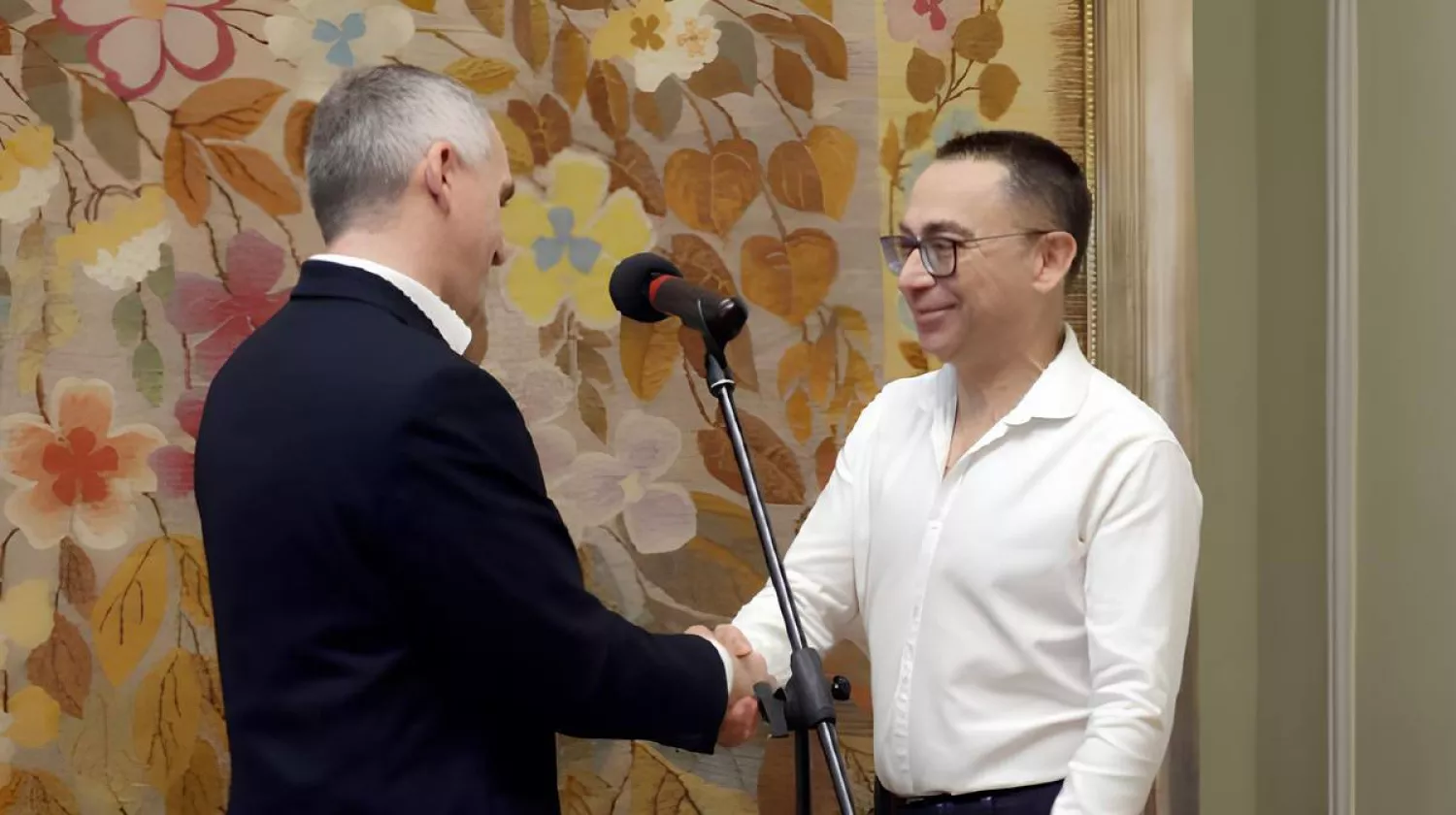 Mayor of Mykolaiv Oleksandr Sienkevych and Yurii Liubarov, head of the city council's Department of Culture
Mayor of Mykolaiv Oleksandr Sienkevych and Yurii Liubarov, head of the city council's Department of CultureThe recent case of the «Dacha Kudriavtseva» monument is illustrative of how the model works, in which heritage protection is a separate area. It was the special department that recorded the violations, documented the work without a security agreement, and became the key institution in initiating criminal proceedings after the illegal dismantling of the historic building.
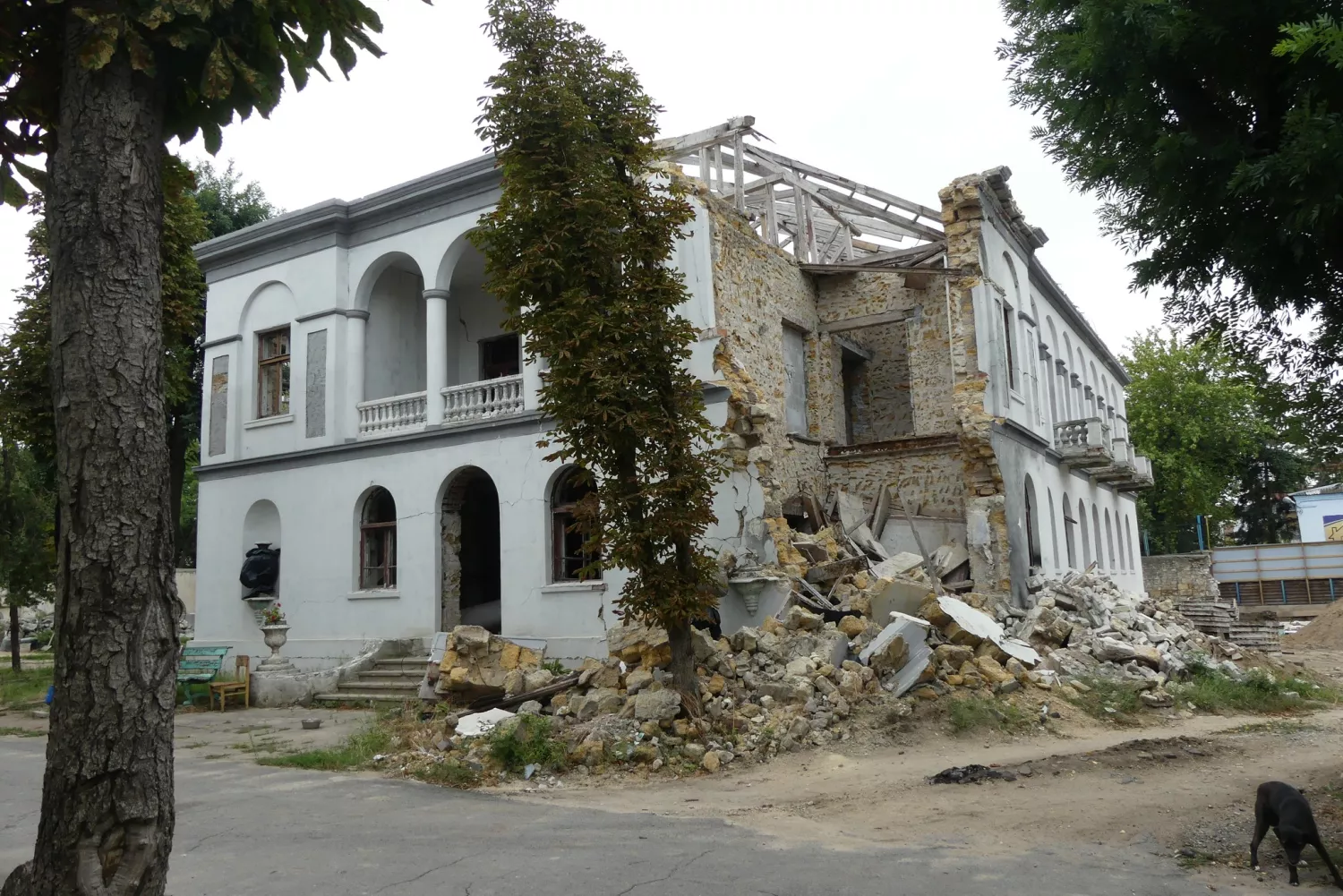 The building of Kudryavtsev's Dacha after the Russian strike in August 2022. Photo by the Mykolaiv Department of Cultural Heritage Protection
The building of Kudryavtsev's Dacha after the Russian strike in August 2022. Photo by the Mykolaiv Department of Cultural Heritage ProtectionAlready during the war, in August 2022, the historic building was damaged by Russian shelling, after which the owner dismantled it without any approval and opened a restaurant with a swimming pool in its place. Based on the materials recorded, among other things, by the Department of Cultural Heritage Protection, criminal proceedings were opened, and the prosecutor's office filed a lawsuit and demanded that the developer restore the monument.
This is an example of how the special department for the protection of cultural heritage acted in accordance with its job description, despite the fact that the founders of the private company that dismantled and built the historic complex are the husband and son of the head of the «Proposal» faction in the Mykolaiv City Council, head of the administration of the city's Inhulskyi district, Hanna Remennikova, Valentyn and Borys Berestniev.
Hanna Remennikova is also a member of the commission that deals with urban planning, architecture, construction and regulation of land relations in Mykolaiv.
The draft of the new structure, which is being submitted to the session by the mayor of Mykolaiv, takes these powers away from Yurii Liubarov and is supposed to transfer the mission of protecting cultural objects from illegal development to Yevhenii Poliakov. In 2024, his department was also given the functions of managing the city's land resources, eliminating the land department.
Doesn't this create a conflict of interest?
NikVesti asked the Department of Culture, Nationalities and Religions of the Mykolaiv Regional Military Administration for a comment, asking whether such a structural change is in line with the state policy in the field of cultural heritage protection and whether it creates risks or a conflict of interest when the body that approves construction or reconstruction must also monitor the preservation of historical buildings and cultural monuments?
«The subordination of the cultural heritage protection body to such a structural unit may create a potential conflict of interest, since structural units for architecture and urban planning are customers or coordinators of construction», said the head of the Department Olena Buberenko.
She emphasised that the main goal of the cultural heritage protection body is to ensure the preservation of historical and cultural values, keep records of monuments, organise their research, protection, promotion, and coordination with cultural institutions, museums, and scientific institutions.
According to her, this area also includes the preservation of elements of the intangible cultural heritage: traditions, customs, oral art, folk crafts and other manifestations of the spiritual culture of the Ukrainian people.
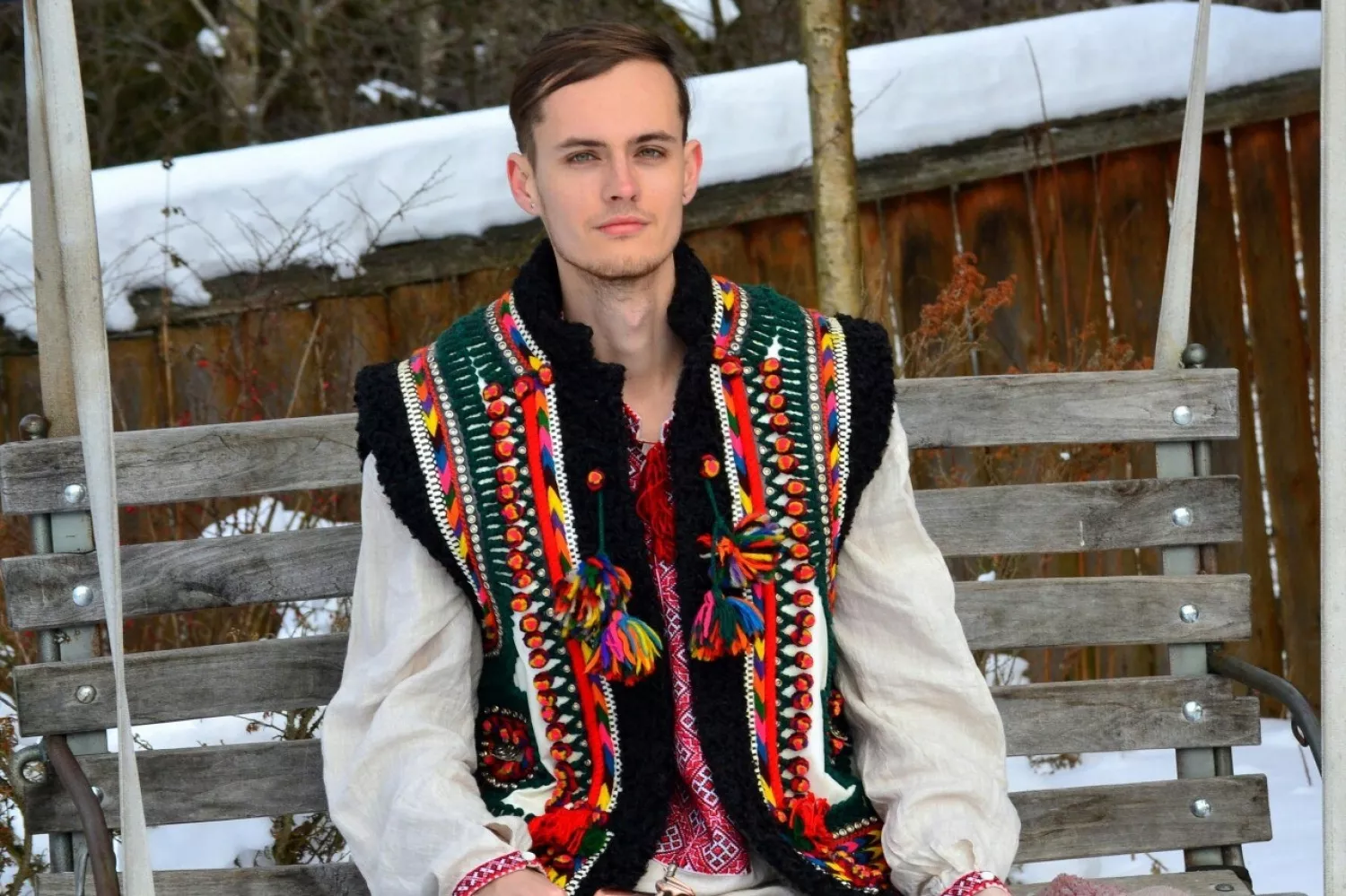 The new structure of the mayor's office transfers the responsibility for folk crafts and spiritual culture to the Department of Urban Development and its head, Yevhen Poliakov. Photo: Facebook of Yevhen Polyakov
The new structure of the mayor's office transfers the responsibility for folk crafts and spiritual culture to the Department of Urban Development and its head, Yevhen Poliakov. Photo: Facebook of Yevhen Polyakov«These functions inherently fall exclusively within the competence of the cultural sector, as they are of a scientific and cultural rather than technical and construction nature. And the structural units for architecture and urban planning implement state policy in the field of spatial planning, land development and architectural design, that is, in the area where the protection of cultural heritage is ancillary, not primary," added Olena Buberenko, head of the regional department.
Archaeological monuments and mounds should be highlighted separately, in particular the so-called «Big Mound» in the Korabelnyi district or the «Dykyi Sad» settlement. All of these are also under the jurisdiction of the Department of Urban Development.
«The protection of archaeological sites is a separate and complex area of activity in the field of cultural heritage protection, requiring specialised knowledge, a scientific approach and constant interaction with professional scientific institutions and law enforcement agencies. This area has its own specifics related to archaeological research, the identification and preservation of archaeological heritage sites, which are often under threat of destruction during economic or construction activities», the regional department of culture said in a response.
Thus, the regional department of culture concludes that the exercise of these powers should not be the responsibility of the body that regulates development.
We would like to point out that even the existence of such a body and its active position is not always a safeguard against abuse and development of historic areas in violation of the rules. In 2016-2017, a three-storey restaurant known as «Mafia» was built on the corner of Central Avenue and Soborna Street.
 The scandalous construction of the restaurant «Mafia» near the historical monument «Tram substation of 1913-1914», editorial archive, 2016
The scandalous construction of the restaurant «Mafia» near the historical monument «Tram substation of 1913-1914», editorial archive, 2016And no matter how many times the then head of the Department of Cultural Heritage Protection wrote to the State Construction Inspectorate «to immediately suspend construction work», the restaurant was built, distorting the view of the architectural monument «Tram substation», which the city council recently agreed to purchase.
This has happened before
At the height of the entrepreneurial boom of the 2000s in Mykolaiv, businesses were actively buying up old buildings and non-residential premises in the city centre. These were historic mansions, basements, monuments, or simply old buildings that had a protected status and belonged to the historical environment of Mykolaiv. As the number of new owners grew, so did the number of conflicts — primarily between entrepreneurs and the city council, which had to issue permits for the repair or reconstruction of such buildings.
Tensions arose when owners sought to reduce the cost of repairs or change the authentic appearance of facades: replace balusters, dismantle stucco or install new elements that did not match the historic appearance of the building. The most illustrative conflicts of that time concerned the so-called «house with Atlanteans» on Pushkinska Street and the repair work in the House of Fleet Officers. The Department for the Protection of Cultural Heritage consistently stopped such attempts at interference and had the legal right to apply to law enforcement agencies in case of violations.
To understand the situation at the time, it is important to recall that in 1994, the Department for the Protection of the Historic Environment and Monuments was established in Mykolaiv. It was initiated by the famous Mykolaiv architect Olha Popova, the author of numerous city monuments and public spaces, and the wife of sculptor Vadym Popov. For many years, she shaped the approach to the preservation of the city's historic environment, insisted on the creation of a separate institution with sufficient powers to protect the architectural heritage, and commissioned the historical and architectural master plan for the city of Mykolaiv.
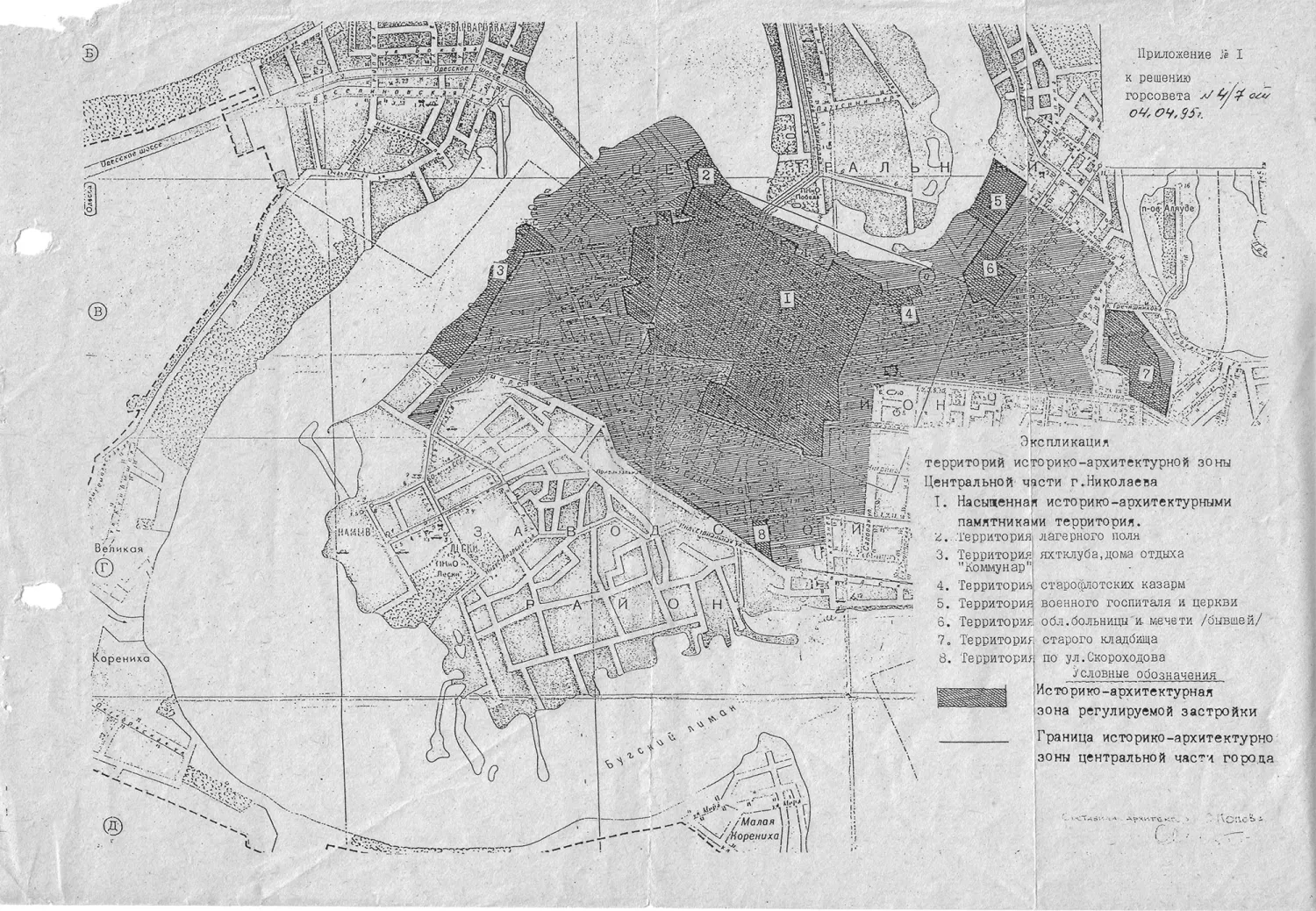 Historical and architectural plan defining the boundaries of the old centre of Mykolaiv, Document: Decision of the Mykolaiv City Council of 4 April 1995.
Historical and architectural plan defining the boundaries of the old centre of Mykolaiv, Document: Decision of the Mykolaiv City Council of 4 April 1995.In 1996, the department was headed by Iryna Bondarenko, who actually shaped the approach to the work of the city's heritage protection system in the following years. One of the witnesses of the events of 2005-2006 recalls for NikVesti:
«It was impossible to agree on anything with Bondarenko and never did. Entrepreneurs wrote complaints, put pressure, demanded permits. But it is thanks to her principled position that a huge number of buildings in the old centre of Mykolaiv have been preserved to this day. She threatened lawsuits, appealed to law enforcement agencies, and demanded that developers comply with the established rules».
The accumulation of conflicts between entrepreneurs and the city authorities, as well as the inconvenience for business of such a «unwavering» position of the heritage guardians, led to a political initiative by part of the city leadership. In 2005-2006, the then chief architect of Mykolaiv, Oleh Starushko, with the support of a number of city council members, tried to get the cultural heritage protection body transferred to the urban planning department that was under his command. In essence, it was a matter of revising the system of checks and balances and redistributing powers.
After lengthy discussions, Mykolaiv Mayor Volodymyr Chaika rejected the proposal. Although the Cultural Heritage Protection Authority lost its status as a separate department, it was incorporated into the new Department of Culture, remaining in the field of culture rather than urban planning. This allowed the institutional independence of the heritage guardians to be preserved and the protection of Mykolaiv's historic environment from chaotic repairs and unsuccessful reconstructions to continue.
The model of that time, although conflicting for developers, ensured the main thing — the presence of a separate arbiter who could resist pressure and act in the interests of preserving the historic environment. The transfer of these functions to those who are also responsible for approving construction means a rejection of this principle.
How does the cultural heritage protection system work in other cities and what model does Mykolaiv choose?
To understand how typical the idea of transferring the protection of cultural heritage to urban planning is, NikVesti contacted the city councils of regional centres. This allows us to see what model cities choose to protect their historic environment.
- The most common model is a separate specialised body.
This is how 11 cities work: Kyiv, Lviv, Dnipro, Odesa, Chernivtsi, Zaporizhzhia, Sumy, Lutsk, Ternopil, Kherson, and Rivne. There, heritage protection is handled by full-fledged departments or offices that have their own staff and clear powers. There are 36 specialists in Kyiv, 19 in Lviv, and 13 in Dnipro. These cities have the largest volume of work with historic buildings, and therefore maintain separate units with their own functions.
- The second model is small sectors or departments within larger departments.
This is how 5 cities work: Cherkasy, Zhytomyr, Vinnytsia, Poltava, and Khmelnytskyi. In these communities, heritage protection exists, but the functions are distributed among 1-2 specialists working within the department of architecture or culture. This is also a working scheme, but in such cases, the direction often depends on the decisions of the heads of other departments.
- The third model is the complete absence of a separate body.
This option has only happened in one city — Chernihiv. There, heritage powers have not been transferred to the community level, so there is no specialised unit at all.
As a result, out of the 18 cities that responded, 11 have a separate body, 5 have a mixed model, and only 1 city does not have a special unit. That is, the most common approach is a separate structure that is not related to urban planning and has its own competence and responsibility.
For those who want to read all the answers in more depth, the editors have prepared a separate folder on Google Drive.
The changes proposed in the new structure of the city hall could radically affect the way decisions about historic buildings and districts are made in Mykolaiv. The city has never before transferred the protection of cultural heritage to a unit that is also responsible for the development and approval of construction work. This is in fact a new model for Mykolaiv, and it requires a balanced assessment, taking into account the experience of other communities and the position of relevant experts.
For a city that has suffered great destruction and is facing a long reconstruction, it is important that decisions on historic buildings are made transparently, professionally and without pressure from those interested in new construction. The configuration that the authorities choose now will determine whether Mykolaiv will be able to preserve its historical fabric during the reconstruction or risk losing part of its cultural identity in the process. The result of the vote on 27 November will show how the city sees its future.
Yuliia Boichenko, NikVesti
This publication was produced within the framework of the Institute for War & Peace Reporting (IWPR) project “Strengthening Public Oversight,” with financial support from Norway. The content of this publication is the sole responsibility of the NGO “Mykolaiv Media Hub” and the online media outlet “NikVesti.” This material can in no way be considered as reflecting the views of IWPR or the Government of Norway.

Чому ви читаєте «МикВісті»? Яка наша діяльність найбільш важлива для вас? Та чи хотіли б ви стати частиною спільноти читачів? Пройдіть опитування, це анонімно і займе 5 хвилин вашого часу


